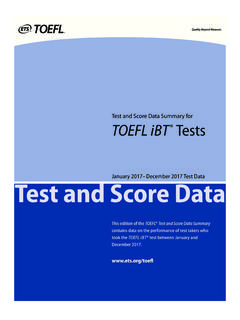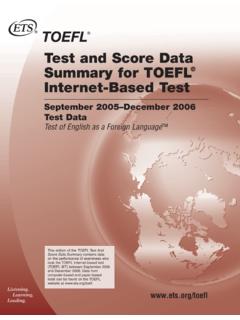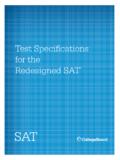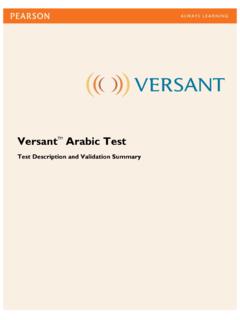Transcription of Principles of Data-Driven Instruction - epd-mh.com
1 Principles of Data-Driven Instruction Education in our times must try to find whatever there is in students that might yearn for completion, and to reconstruct the learning that would enable them autonomously to seek that completion. Allan Bloom Linda Thompson The term Data-Driven Instruction refers to a teacher's use of the results from various student assessments to plan Instruction . Research has shown this process to be an effective way to improve student achievement. What is required for Data-Driven Instruction ? Several requirements are necessary to achieve good Data-Driven Instruction : n Baseline data that gives a good sense of where students are at the beginning of the year; these data often come from the prior year's state test because schools are held accountable by such tests. n Clear goals for what students are expected to learn and to achieve; these goals are usually related to state standards and grade-level expectations.
2 Goals may also be specific to improved performance on the state test, for example, raising the percentage of students scoring Proficient or higher in mathematics from 67% last year to 84% this year. n Regular assessments across the school year; frequent assessments provide multiple pieces of evidence about student knowledge and skills. Such assessments help to benchmark students' progress across the school year. n Well-focused and well-planned Instruction that is based on evidence; these data show what students know and are able to do and what they still need to learn. What kinds of tests inform Data-Driven Instruction ? You will find that you can use a variety of tests for Data-Driven Instruction , but all of them Copyright by The McGraw-Hill Companies, Inc. should be reliable, valid, and aligned to the standards, concepts, and skills students are expected to learn.
3 These standards-aligned tests can include state tests and benchmark tests that are administered several times each year and cover all standards. You can even use chapter or unit tests that assess a specific standard or subset of standards. How do you use the tests to inform Instruction ? Start with a Class Summary of Test Results. The Class Summary should report results in terms of the applicable standards and should have specific information about the grade- level expectations and even what the test items addressed. The following sample shows a small portion of a Class Summary and includes percentages of items answered correctly for each skill and the average percentage for each Strand. From a Class Summary, you can identify strands in which students did well and those in which they had difficulty. A plan of Instruction can be based on information from a Class Summary.
4 The Leadership Handbook An Administrator's Quick Reference Guide Principles of Data-Driven Instruction 57. Principles of Data-Driven Instruction Class Summary of Test Results Strand: Reading (64%). Comprehension n Determine a text's main (or major) ideas and how those ideas are supported with details. (80%). n Distinguish fact and opinion in various texts. (71%). n Find similarities and differences across texts, such as, in treatment, scope, or organization. (44%). n Paraphrase and summarize text to recall, inform, and organize ideas. (65%). Literary Concepts n Identify the purposes of different types of texts, such as to inform, influence, express, or entertain. (49%). n Recognize the distinguishing features of genres, including biography, historical fiction, informational texts, and poetry. (76%). n Understand and identify literary terms, such as title, author, illustrator, playwright, theater, stage, act, dialogue, and scene, across a variety of literary forms (texts).
5 (66%). Strand: Writing (64%). Writing process n Generate ideas and plans for writing by using such prewriting strategies as brainstorming, graphic organizers, notes, and logs. (79%). n Develop drafts by categorizing ideas, organizing them into paragraphs, and blending paragraphs within larger units of text. (69%). n Revise drafts for coherence, progression, and logical support of ideas. (69%). n Edit drafts for specific purposes, such as to ensure standard usage, varied sentence structure, and appropriate word choice. (39%). n Proofread his or her own writing and that of others. (41%). Copyright by The McGraw-Hill Companies, Inc. Inquiry/Research n Frame questions to direct research. (34%). n Summarize and organize ideas gained from multiple sources in useful ways, such as outlines, conceptual maps, learning logs, and timelines. (42%).
6 N Organize prior knowledge about a topic in a variety of ways, such as producing a graphic organizer. (85%). Evaluation n Analyze published examples as models for writing. (92%). n Review a collection of written works to determine its strengths and weaknesses and to set goals as a writer. (85%). The Leadership Handbook An Administrator's Quick Reference Guide Principles of Data-Driven Instruction 58. Principles of Data-Driven Instruction What is the process for achieving Data-Driven Instruction ? First: Target areas where students are having difficulty. This is basically a sorting exercise to identify n strengths areas in which the class as a whole did quite well n challenges areas in which the class did fairly well but were not strong n critical needs areas in which the class did not perform well The sample Class Summary shows that students struggle with finding similarities and differences across texts (in Comprehension) and editing their own work for sentence structure, usage, and word choice (in Writing Process).
7 The sorting is not based simply on which strands received the highest or lowest scores. It is based on criteria that place class performances into three categories. Typically, you look at the average percentage of all items answered correctly in each strand and apply predetermined criteria. For example: n Strength: 80% or higher Most students were able to answer correctly the majority of questions on the tested content. n Challenge: 65% 79% Most students had a moderate understanding of the tested content. n Critical Need: less than 65% Most students struggled with the tested content. To select targets for Data-Driven Instruction , start with the Critical Needs strands. In the sample, the strands for Reading (64%) and Writing (64%) both qualify as Critical Needs. Next, you will select standards or grade-level expectations within those strands for intervention.
8 It is usually more effective to target improvement efforts on a limited number of concepts, so focus intervention on two or three areas. Second: Focus on specific needs. After identifying the Critical Needs strands, drill down within a strand. Look at the grade-level expectations and do an item analysis of the skills and concepts. Copyright by The McGraw-Hill Companies, Inc. In the targeted strands, are there specific skills or concepts your students understand? Can you build on Instruction using those skills? Are there specific areas in which students have difficulty? What are the weakest areas? Drilling down inside a strand to specific grade-level expectations or standards in which students are weak will help you clarify what students understand and where they need more Instruction . The item analysis provides information about patterns or trends within student competencies and areas of weakness.
9 In the Reading and Writing strands of the sample Class Summary, an item analysis shows that students are not weak in all of the grade-level expectations. Indeed, they are quite strong in some areas. For example, it is apparent that students were relatively strong in mechanical skills, or tasks in which rules could be memorized and applied, but they were weak in applying knowledge to new situations and in synthesizing information. They can identify an adjective but do not understand how to use one to improve their own writing. The Leadership Handbook An Administrator's Quick Reference Guide Principles of Data-Driven Instruction 59. Principles of Data-Driven Instruction Remember that when you review a single strand, you are seeing a sample of the concepts and skills within that domain. It is not possible to assess the full range of skills for every possible grade-level expectation.
10 A test that did so would be too long and inefficient. However, well-chosen samples of the expected skills will provide a general reflection of what students know and can apply in that area. If they are available, an examination of answer choices can provide additional insights into student understanding. Many test-item distracters are selected because they represent common errors. If many students select a single wrong answer, it can suggest a commonly held misconception. Generally, you should take care not to isolate test items as fragments . to be taught. This would be teaching to the test, an ineffective and unethical practice. Rather, look for clusters or patterns within the items that help clarify what students know and do not know. This tells you where previous Instruction was effective and where more Instruction is needed. Analysis of test data to provide instructional focus can be done for a single test but is more effective when multiple pieces of information are brought to the process.







